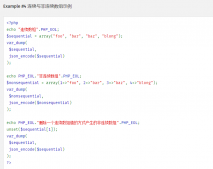1、markTestSkipped和markTestIncomplete
在phpunit中,有两个有用的方法markTestSkipped和markTestIncomplete。它们能允许你编写的单元测试中不单是只有通过和失败两种结果。markTestSkipped能让PHPUNIT不去执行某个已经编写好的测试方法。举个例子说明,比如下面的程序:
><?php
>public function testThisMightHaveADb()
>{
> $myObject->createObject();
> try {
> $db = new Database();
> $this->assertTrue($db->rowExists());
> } catch (DatabseException $e) {
> $this->markTestSkipped('This test was skipped because there was a database problem');
> }
>}
>?>
在上面的程序中,是一个连接数据库后,判断数据是否存在的测试方法,但如果考虑数据库的连接异常的话,则应该在抛出异常时,使用markTestSkipped指出该测试方法应该是被忽略的,因为出现了异常,而注意的时,此时有可能你写的代码是正确的,只不过是出现了异常而已,这样phpunit在输出时就不会只是简单的输出fail。
而markTestIncomplete也有点类似,但有点不同的是,它是当开发者在编写一个未完成的测试方法时使用的,标记出某个测试方法还没编写完成,同样测试结果也不会是fail,只是告诉phpunit这个测试方法还没编写完成而已,例子如下:
><?php
>public function testAreNotEnoughHours()
>{
> $this->markTestIncomplete("There aren't enough hours in the day to have my tests go green");
> $trueVariable = true;
> $this->assertTrue($trueVariable);
>}
>?>
2、更深入了解phpunit中的断言
在上一篇文章中,已经基本讲解了一些基本的phpunit中的断言的使用,这里以一个例子,下面是一个类的代码:
><?php
>class Testable
>{
> public $trueProperty = true;
> public $resetMe = true;
> public $testArray = array(
> 'first key' => 1,
> 'second key' => 2
> );
> private $testString = "I do love me some strings";
> public function __construct()
> {
> }
> public function addValues($valueOne,$valueTwo) {
> return $valueOne+$valueTwo;
> }
> public function getTestString()
> {
> return $this->testString;
> }
>}
>?>
我们编写的单元测试代码初步的框架如下:
><?php
>class TestableTest extends PHPUnit_Framework_TestCase
>{
> private $_testable = null;
> public function setUp()
> {
> $this->_testable = new Testable();
> }
> public function tearDown()
> {
> $this->_testable = null;
> }
> /** test methods will go here */
>}
>?>
在上一篇文章中,已经介绍了setUp方法和tearDown方法,这里的setUp方法中,建立了Testable()实例并保存在变量$_testable中,而在tearDown方法中,销毁了该对象。
接下来,开始编写一些断言去测试,首先看assertTrue和assertFalase:
><?php
>public function testTruePropertyIsTrue()
>{
> $this->assertTrue($this->_testable->trueProperty,"trueProperty isn't true");
>}
>public function testTruePropertyIsFalse()
>{
> $this->assertFalse($this->_testable->trueProperty, "trueProperty isn't false");
>}
>?>
在上一篇文章中已经介绍过assertTrue和assertFalse了,这里留意一下其中的第二个参数,其含义是,当该断言的测试不通过时,自定义的显示信息。比如在这个测试方法中,当trueProperty不为真值时,将显示“trueProperty isn't true”的信息。
接下来再看下在数值方面上phpunit的断言使用实例:
><?php
>public function testValueEquals()
>{
> $valueOne = 4;
> $valueTwo = 2;
> $this->assertEquals($this->_testable->addValues($valueOne,$valueTwo),6);
>}
>public function testValueGreaterThan()
>{
> $valueOne = 4;
> $valueTwo = 2;
> $this->assertGreaterThan($valueTwo,$valueOne);
>}
>public function testLessThanOrEqual()
>{
> $valueOne = 4;
> $valueTwo = 2;
> $this->assertLessThanOrEqual($valueTwo,$valueOne);
>}
>public function testAreObjectsEqual()
>{
> $testTwo = new Testable();
> $this->_testable->resetMe = false;
> $this->assertEquals($this->_testable,$testTwo);
>}
>?>
其中,assertEquals为判断是否相等,assertGreaterThan为判断是否大于,assertLessThanOrEqual判断是否小于或等于,而assertEquals这里要注意一下,它还可以用来判断两个对象是否相等,比如这里就判断了$testTwo这个Testable类的实例是否和新设置的resetMe这个对象相等。
除了在数值方面的断言外,在字符方面还有一些很多断言的功能,看下面的代码:
><?php
>public function testStringEnding()
>{
> $testString = $this->_testable->getTestString();
> $this->assertStringEndsWith('frood',$testString);
>}
>public function testStringStarts()
>{
> $testString = $this->_testable->getTestString();
> $this->assertStringStartsWith('hoopy',$testString);
>}
>public function testEqualFileContents()
>{
> $this->assertStringEqualsFile('/path/to/textfile.txt','foo');
>}
>public function testDoesStringMatchFormat()
>{
> $testString = $this->_testable->getTestString();
> $this->assertStringMatchesFormat('%s',$testString);
>}
>?>
其中, assertStringStartsWith断言是判断字符串是否以指定的字符串开头,assertStringEndsWith断言判断字符串是否以指定的字符串结尾。assertStringEqualsFile断言判断给定的文件中是否含有指定的字符,比如这里就判断textfile.txt这个文件中是否包含字符串foo。
而assertStringMatchesFormat可以让用户指定匹配的模式去判断一个字符串是否符合要求,如 $this->assertStringMatchesFormat('%s',$testString);
这里则判断$testString是否是字符串类型,具体的可以参考phpunit手册。
再来看如下的代码:
><?php
>public function testStringIsNotNull()
>{
> $notANull = “i'm not a null!”;
> $this->assertNull($notANull);
>}
>public function testStringIsSame()
>{
> $numberAsString = '1234';
> $this->assertSame(1234,$numberAsString);
>}
>?>
其中assertNull判断某个变量是否为null,而assertSame则严格判断两个变量是否同一个类型,尽管在PHP中是弱类型语言,但这里通过assertSame还是能判断出$numberAsString为字符串类型,跟期望的1234数字类型不匹配,所以测试不能通过。
最后我们来看一下平常可能不大常用的断言,但又可能对你的单元测试工作十分有帮助的,先看代码如下:
><?php
>public function testArrayKeyExists()
>{
> $this->assertArrayHasKey('first key',$this->_testable->testArray);
>}
>public function testAttributeExists()
>{
> $this->assertClassHasAttribute('resetMe',get_class($this->_testable));
>}
>public function testFileIsReal()
>{
> $this->assertFileExists('/path/to/file.txt');
>}
>public function testIsInstance()
>{
> $this->assertInstanceOf('OtherClass',$this->_testable);
>}
><?php
>public function testDoesMatchRegex()
>{
> $testString = $this->_testable->getTestString();
> $this->assertRegExp('/[a-z]+/',$testString);
>}
>?>
代码中第一个断言assertArrayHasKey,是用来检查一个数组中是否每个键值都是存在的,比如我们的数组中,“firstkey”这个值是有键1与其对应的,所以测试能通过。而assertClassHasAttribute则能判断某个类是否有相应的属性,这个例子中测试也能通过;
而assertFileExists则判断在本地文件系统中是否存在指定的文件。而assertInstanceOf则判断某个你正在创建的对象是否为某个类的实例。assertRegExp相信大家都知道,这个是判断某个字符串中是否与给定的正则表达式相匹配。
总结
本文进一步探讨了PHPUNIT中一些重要的方法和断言,PHPUNIT中还有大量丰富的断言,对提高单元测试十分有帮助,具体的请参考PHPUNIT用户手册。












